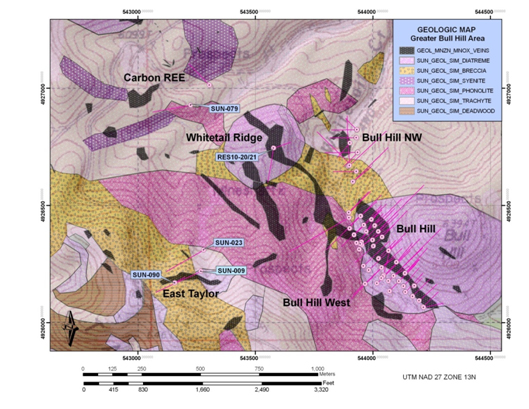Rare Element Resources Ltd. (NYSE Amex: REE and TSX: RES) is pleased to announce the results of an updated NI 43-101-compliant mineral resource estimate of rare-earth elements ("REE") plus yttrium contained in three deposits located in the Bull Hill area of the Bear Lodge project, Wyoming.
- High-grade Measured and Indicated (M & I) mineral resource of 6.8 million tons at 3.75% REO
- Additional high-grade Inferred mineral resource of 24.2 million tons at 2.74% REO including 17.7 million tons at 3.10% REO (at 2% cutoff grade)
- All of the M & I resource and 16.5 million tons of the Inferred resources -- near-surface oxide and oxide-carbonate mineralization
- Significant potential for further expansion of all deposits
Rare Element Resources Ltd. (NYSE Amex: REE and TSX: RES) is pleased to announce the results of an updated NI 43-101-compliant mineral resource estimate of rare-earth elements ("REE") plus yttrium contained in three deposits located in the Bull Hill area of the Bear Lodge project, Wyoming (Figure 1). The updated resource estimate of the Bull Hill deposit consists of 6.8 million tons (6.2 mm metric tonnes) averaging 3.75% REO in Measured and Indicated categories, increased from 4.9 million tons (4.4 mm metric tonnes) averaging 3.77% REO last year, both using a 1.5% REO cutoff grade (Table 1). Table 2 documents the Inferred mineral resources, which have a substantial increase. The total pounds of REO contained in all the high-grade deposits in all resource categories increased by 26% from 1,450 million pounds (660 million kg) to 1,830 million pounds (830 million kg) (Table 3). The interim resource estimate of the M & I categories of Bull Hill was provided for inclusion in our current Preliminary Feasibility Study. However, it includes less than half of the new assay results from holes drilled in 2011. The resources estimate will be updated again by the end of the second quarter of 2012, utilizing all of the 2011 drill holes. The mineral resources were estimated by Ore Reserves Engineering (ORE), an independent consultant.
"The Bear Lodge project continues to advance rapidly. The current upgraded Bull Hill resource will be used in the Prefeasibility Study, scheduled for completion in Q1 2012. The Company's 2011 exploration program completed a record number of drill holes, although the results of less than half of the holes have been received and logged. These interim updated results have expanded and upgraded the known resources, and discovered targets with substantial potential for defining additional rare-earth resources with significant middle and heavy REE-enrichment. We will continue pilot plant metallurgical tests this year and expand our REO separation testing. With the anticipated completion of a positive Prefeasibility Study, we will begin working immediately on a Feasibility Study of the Bear Lodge project. The Company is also transitioning to a management and operations team of highly skilled engineers and mining professionals," stated Dr. Don Ranta, Chairman of Rare Element Resources.
The new resource estimate is derived from an REE database that includes 117 core drill holes completed by the Company between 2008 and 2011. The estimate focuses on the dike sets in the main Bull Hill deposit (including Bull Hill West), plus the Bull Hill Northwest and Whitetail Ridge deposit areas (Figure 1). In addition, the drilling indicates significant potential for expansion of all three deposits, for discovering mineralization in the undrilled areas between the deposits, and for definition of heavy REE-enriched resources in the East Taylor and Carbon targets, which were both drilled during the year.
The total mineral resources estimate by ORE for the three deposits is summarized in the following tables at a range of cutoff grades and for the different oxidation zones, including the oxide, oxide-carbonate, transitional, and sulfide/unoxidized zones (Tables 1 and 2):
Table 1. Total Measured and Indicated Tons and Grade of the Various Oxidized Zones at a Range of Cut-Off Grades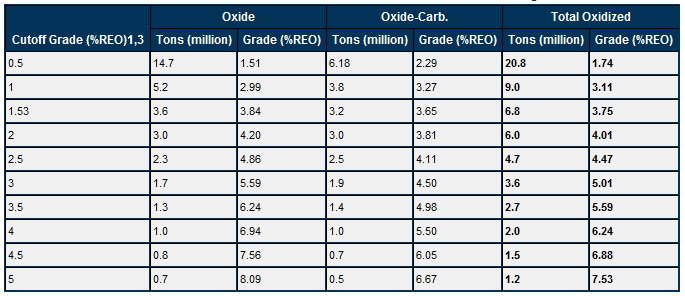
Table 2. Total Inferred Tons and Grade of the Various Oxidation Zones at a Range of Cut-Off Grades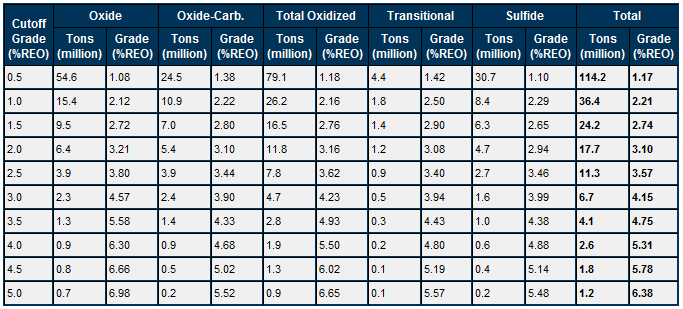
Table 3. Resource Estimates and Contained REO for the Three Individual Deposits.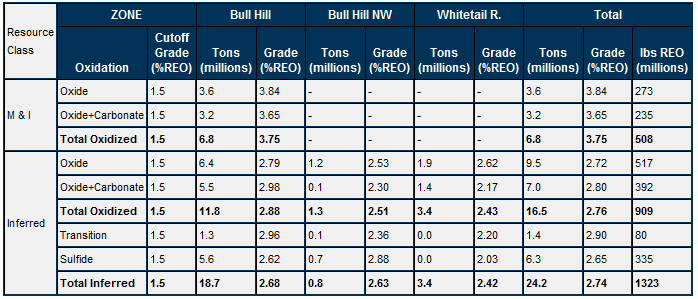
The distribution of individual rare earth oxides for the total measured, indicated, and inferred resources in the oxide and oxide-carbonate zones are given in Tables 4 and 5, respectively.
Table 4. Detailed Rare-Earth-Element Grades of Individual REO for Measured and Indicated Resources of Oxide and Oxide-Carbonate Zone Mineralization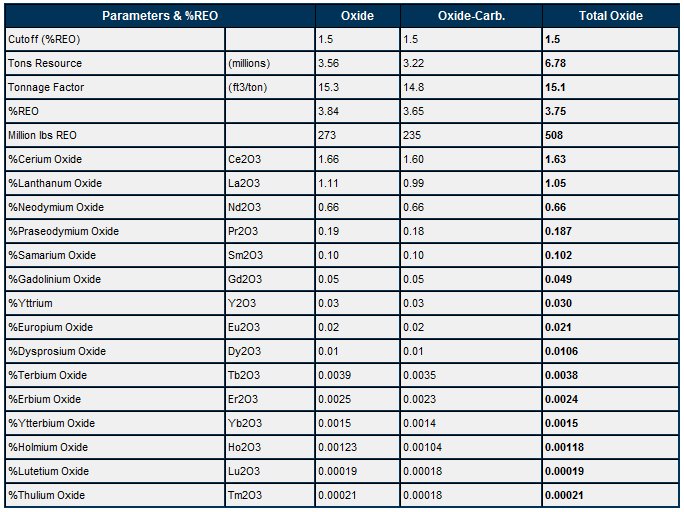
Table 5. Detailed Rare-Earth Element Grades of Individual REO for Inferred Resources of All Mineralized Zones
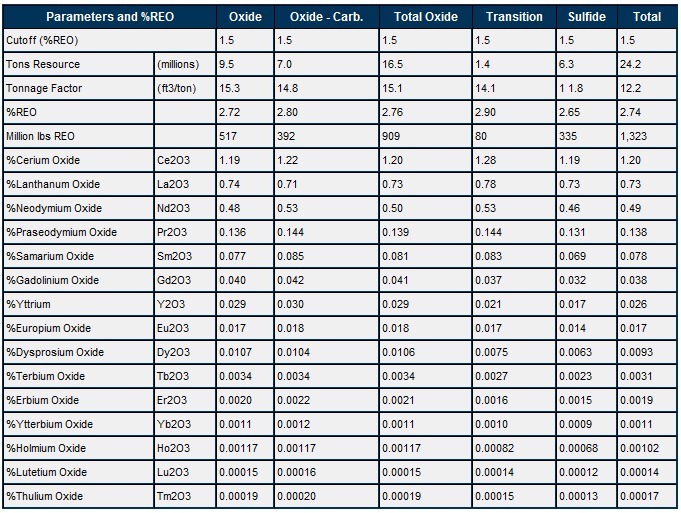
-
REO (rare-earth oxides) include Ce2O3, La2O3, Nd2O3, Pr2O3, Sm2O3, Gd2O3,, Y2O3,, Eu2O3,, Dy2O3 , Tb2O3,, Er2O3 and other minor oxides listed in general order of decreasing abundance in the deposits (Tables 4 and 5).
-
The resources estimates are classified as Measured, Indicated, and Inferred Mineral Resources as defined by CIM and referenced in NI 43-101.
-
ORE considers a range of 1.0 to 2.5 per cent REO cut-off grade to be reasonable in estimation of potentially economic resources. A cutoff grade of 1.5% REO has been selected as the base case and it is highlighted; a cutoff grade of 3.0% REO is also highlighted to show the higher-grade tons above the cutoff. Low-grade material above 0.5% cut-off grade is undergoing metallurgical testing to determine if a simple low-cost process can result in its being upgraded.
-
A detailed program of core sampling and bulk density measurement was conducted successfully during the 2010-11 drilling programs, especially for oxide mineralization to ensure the most accurate data.
Resources were estimated using inverse distance weighting with grade zones to differentiate between high-grade and stockwork mineralization. High-grade mineralization was defined as a minimum 30 feet (6.1m) true width above 1.5% for the main southwest area. Slightly different cutoff grades and minimum widths were used in other areas. Drill holes were composited to nominal 10-foot (3.05m) true-width intervals for estimation. Grades were not capped, but oxide and oxide-carbonate grades were adjusted downward for estimation of the transition and sulfide zones to compensate for the significant increase in grade in the oxidized zones. Grades were estimated using trend surfaces to interpolate parallel to the carbonatite/FMR dike orientation. The resource model blocks are 10 X 10 X 10-foot cubes. Based on 4-year average REO prices, the cutoff grade of 1.5% REO was selected near the high-point of a range of likely cost scenarios. As additional data are gathered, work will continue on the resource estimates with further evaluation and refinement.
Geology and Mineralization
The Bull Hill deposit (formerly known as Bull Hill Southwest) contains the bulk of the current resources. The deposit comprises a steeply-dipping FMR-carbonatite dike swarm with a dominant northwesterly trend. FMR refers to the major constituents of the highly oxidized, former carbonatite dikes that occur from the surface to 500 to 600 feet beneath the surface--F (FeOx)-M (MnOx)-R (REE minerals). FMR bodies range in size from veinlets to large dikes more than 100 feet in width and transition to carbonatite dikes as deep as 600 feet. In some portions of the dikes, FMR transitions laterally or vertically to oxide-carbonate dikes that retain some or all of their gangue carbonates and can occur from the surface to similar depths. The Bull Hill Northwest deposit shares many characteristics with the Bull Hill Southwest deposit. It appears that northerly-striking mineralized bodies predominate. The dikes are part of an FMR/carbonatite dike system that is most likely separate from the Bull Hill dike system.
The Whitetail Ridge deposit is more enriched in heavy rare earths and is distinguished by a zone of FMR stockwork, some dikes, and a coincident geophysical anomaly. The size of the geophysical anomaly (approximately 1,400 by 2,000 feet elongate northeasterly) provides an indication that the REE target may be larger than others in the district. Only a part of this target area has been tested by the Company's drill holes. Whitetail Ridge is a key target for further resource development drilling during 2012.
The major dike sets in all of the resource areas are accompanied by peripheral zones of lower-grade stockwork REE mineralization. The term "stockwork" refers to a rock cut by a network of small veins or dikes that contain the mineralization. REE grades in the stockwork zones range between about 0.5 to 2% REO. The Company is investigating low-cost physical processing methods to upgrade the contained REE mineralization in the stockwork for eventual inclusion with the resources.
Cutoff Grade & Metallurgy
The resource size is sensitive to an assumed cut-off grade, which is sensitive to metallurgical operating costs. The Company is advancing its rare-earth metallurgical studies at: 1) Mountain States Research & Development International, Vail, Arizona, 2) Nagrom, Perth, Australia, and 3) Hazen Research, Golden, Colorado. The objective for each of these testing laboratories is developing and optimizing an effective and cost-efficient metallurgical flowsheet. The metallurgical testing program will continue through 2012 on mineralized bulk core samples and surface bulk samples collected during 2011. Metallurgy of the FMR oxide zone is well established and has been reported previously. Metallurgical testing of the oxide-carbonate zone resource is progressing.
Mineral Resources are not Reserves
Mineral resources that are not mineral reserves do not have demonstrated economic viability. Mineral resource estimates do not account for minability, selectivity, mining loss, and dilution. These mineral resource estimates are in the measured, indicated, and inferred mineral resource categories. Inferred mineral resources are normally considered too speculative geologically for the application of economic considerations that would enable them to be categorized as mineral reserves. There is also no certainty that these inferred mineral resources will be converted to measured and indicated mineral resource categories through further drilling, or into mineral reserves once economic considerations are applied.
Quality Assurance
The mineral resource estimate was completed by Mr. Alan C. Noble, P.E., principal engineer of Ore Reserves Engineering, and is based on geological interpretations supplied by the Company to ORE and subsequently modified by ORE. Mr. Noble is an independent qualified person for the purposes of National Instrument 43-101 standards of disclosure for mineral projects of the Canadian Securities Administrators and has verified the data disclosed in this release.
The Rare Element Resources' field programs were carried out under the supervision of Dr. James G. Clark, the Company's Vice President of Exploration, John Ray, and by Dr. Ellen Leavitt, who is a qualified person for the purposes of National Instrument 43-101 standards of disclosure for mineral projects of the Canadian Securities Administrators. A detailed QA/QC program was implemented for the 2007 through 2011 drill programs. The QA/QC program was organized by Dr. Jeffrey Jaacks. Dr. Jaacks and Dr. Clark have verified the sampling procedures and QA/QC data delivered to ORE. They share the opinion that the data are of good quality and suitable for use in the resource estimate.
A full table of significant drill results from the Company's 2004-2011 exploration programs, along with maps and sections detailing the drill-hole locations, are available at: http://www.rareelementresources.com
Markets for Rare Earths
Rare-earth elements are key components of the green energy technologies and other high-technology applications. Some of the major applications include hybrid automobiles, plug-in electric automobiles, advanced wind turbines, computer hard drives, compact fluorescent light bulbs, metal alloys in steel, additives in ceramics and glass, petroleum cracking catalysts, and many others. China currently produces more than 96% of the 124,000 tonnes of rare-earths consumed worldwide annually, and China has been reducing its exports of rare earths each year. The rare-earth market is projected to grow rapidly as these green technologies are implemented on a broad scale. Rare earths are critical and enabling metals for the green technologies.
Rare Element Resources Ltd. (NYSE Amex: REE and TSX: RES) is a publicly traded mineral resource company focused on exploration and development of rare-earth elements and gold. In addition to the REE exploration and evaluation efforts, the Company is exploring for gold on the Sundance project, which is located on the same property in Wyoming.
ON BEHALF OF THE BOARD
Anne Hite, Director of Investor Relations
For information, refer to the Company's website at www.rareelementresources.com
or contact Anne Hite, 720-278-2466
Donald E. Ranta, PhD, PGeo, serves the Board of Directors of the Company as an internal, technically Qualified Person. Technical information in this news release has been reviewed by Dr. Ranta, in addition to the others mentioned above, and has been prepared in accordance with Canadian regulatory requirements that are set out in National Instrument 43-101. This news release was prepared by Company management, which takes full responsibility for content. Neither the TSX nor its Regulation Services Provider (as that term is defined in the policies of the TSX) accepts responsibility for the adequacy or accuracy of this release.
Forward Looking Statements
Except for statements of historical fact, certain information contained herein constitutes forward-looking statements. Forward looking statements are usually identified by our use of certain terminology, including "will", "believes", "may", "expects", "should", "seeks", "anticipates", "has potential to", or "intends' or by discussions of strategy or intentions. Such forward-looking statements involve known and unknown risks, uncertainties and other factors which may cause our actual results or achievements to be materially different from any future results or achievements expressed or implied by such forward-looking statements. Forward-looking statements are statements that are not historical facts, and include but are not limited to, estimates and their underlying assumptions; statements regarding plans, objectives and expectations with respect to the effectiveness of the Company's business model; future operations, products and services; the impact of regulatory initiatives on the Company's operations; the size of and opportunities related to the market for the Company's products; general industry and macroeconomic growth rates; expectations related to possible joint and/or strategic ventures and statements regarding future performance.
Forward-looking statements used in this discussion are subject to various risks and uncertainties, most of which are difficult to predict and generally beyond the control of the Company. If risks or uncertainties materialize, or if underlying assumptions prove incorrect, our actual results may vary materially from those expected, estimated or projected. Forward-looking statements in this document are not a prediction of future events or circumstances, and those future events or circumstances may not occur. Given these uncertainties, users of the information included herein, including investors and prospective investors are cautioned not to place undue reliance on such forward-looking statements.
Figure 1 Location Map of the Bull Hill, Bull Hill Northwest, and Whitetail Ridge areas.
